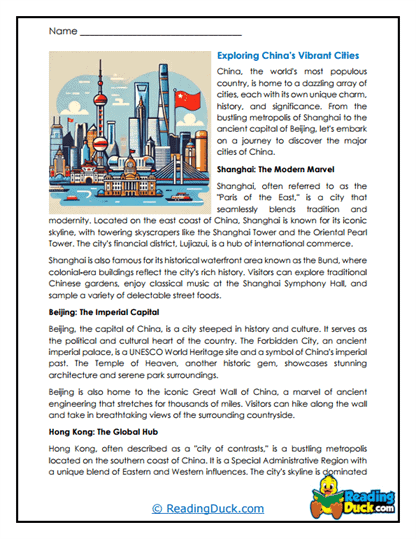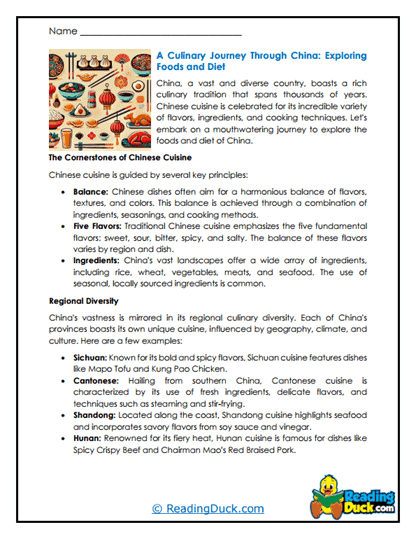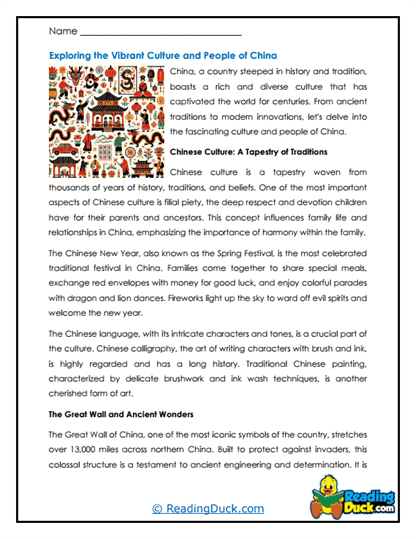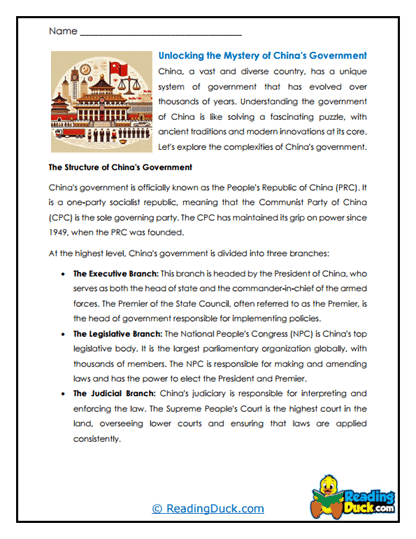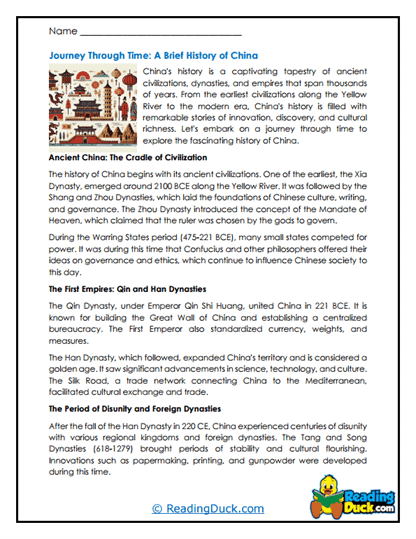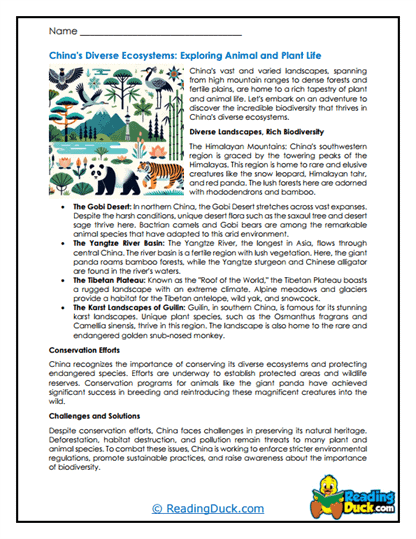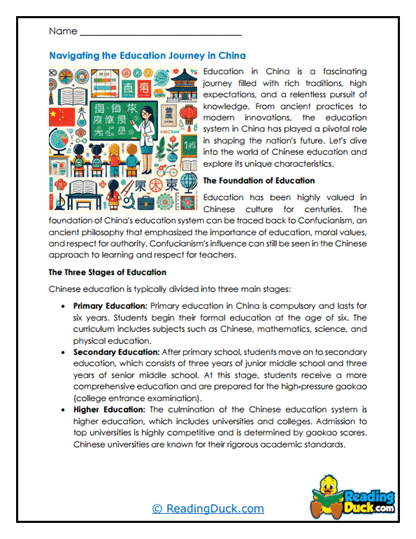China Worksheets
About Our China Worksheets
Our collection of China worksheets offers an engaging and comprehensive exploration of one of the world's most ancient and influential civilizations. These worksheets, categorized under Social Studies: World History, help students delve into various aspects of China, from its rich cultural heritage and complex history to its vast geography and significant global impact. Each worksheet set is thoughtfully designed to reinforce key concepts and encourage critical thinking through a variety of question formats and visually engaging content.
Each worksheet set includes:
- Multiple Choice Questions: These questions assess students' understanding of the reading passage by offering several answer options, reinforcing essential facts and concepts about China’s history, culture, and geography.
- Short Answer Questions: In this section, students are encouraged to write their own answers based on the reading passage. This format allows students to express their understanding in their own words, deepening their comprehension of the material.
- Open-Ended Questions: These questions prompt students to provide personal input, opinions, or reflections related to the reading material. This format encourages students to connect the topic of China to their own experiences and broader understanding of world history.
An answer key is provided for every question sheet, making it easy for teachers and parents to review and assess students' work. All worksheets are available as PDF files, which can be easily viewed electronically, downloaded, and printed out for use in classrooms or homeschool settings.
Unveiling China: A Journey Through History, Culture, and Geography
China is a country with a long and complex history that has significantly influenced the development of world civilization. When introducing students to China, it's important to explore its historical roots, diverse cultural practices, and the geographical features that have shaped its development. Understanding these aspects helps students appreciate the rich tapestry of China’s past and its role in the modern world.
Historical Background
- Ancient Dynasties
- Early Civilizations: China’s history stretches back over 4,000 years, beginning with the earliest known dynasties such as the Xia, Shang, and Zhou. These early civilizations laid the foundations for Chinese culture, including the development of writing, agriculture, and early forms of governance. The Zhou Dynasty, in particular, introduced the concept of the "Mandate of Heaven," which justified the rule of emperors and became a central part of Chinese political philosophy.
- The Qin and Han Dynasties: The Qin Dynasty (221-206 BCE) was significant for unifying China under the first emperor, Qin Shi Huang. He is also known for beginning the construction of the Great Wall and the Terracotta Army. The Han Dynasty (206 BCE-220 CE) followed and is often considered a golden age in Chinese history, with advances in science, technology, and trade, including the expansion of the Silk Road, which connected China to the rest of the world.
- Imperial China and Cultural Flourishing
- Tang and Song Dynasties: The Tang (618-907) and Song (960-1279) Dynasties were periods of great cultural and technological achievements. The Tang Dynasty is known for its poetry, art, and the expansion of the empire, while the Song Dynasty is celebrated for innovations such as gunpowder, the compass, and printing. These dynasties set the stage for China’s long-lasting influence on global culture and technology.
- Ming and Qing Dynasties: The Ming (1368-1644) and Qing (1644-1912) Dynasties marked the final eras of imperial China. The Ming Dynasty is renowned for its construction projects, including the completion of the Great Wall and the Forbidden City in Beijing. The Qing Dynasty, despite its eventual decline, saw China become one of the most powerful and populous nations in the world before facing internal strife and external pressures in the 19th and early 20th centuries.
Culture, Geography, and Government
- Cultural Heritage
- Philosophy and Religion: China is the birthplace of major philosophical and religious traditions, including Confucianism, Taoism, and Buddhism. Confucianism, with its emphasis on social harmony, respect for elders, and education, has deeply influenced Chinese society. Taoism, with its focus on living in harmony with nature, and Buddhism, which was introduced from India, also play significant roles in Chinese culture.
- Arts and Literature: China has a rich tradition of arts and literature, including calligraphy, painting, poetry, and ceramics. Chinese opera, particularly the Peking Opera, is a unique form of theatrical performance that combines music, vocal performance, mime, and acrobatics. Classical Chinese literature, such as the "Four Great Classical Novels," continues to be celebrated both in China and around the world.
- Geography and Natural Wonders
- Vast and Diverse Landscapes: China’s geography is vast and diverse, ranging from the towering Himalayas in the southwest to the fertile plains of the Yangtze and Yellow Rivers, which are the cradle of Chinese civilization. The country’s varied climate and landscapes support a wide range of ecosystems, making China one of the most biodiverse countries in the world.
- Landmarks and Heritage Sites: China is home to numerous UNESCO World Heritage Sites, including the Great Wall, the Forbidden City, and the Terracotta Army. These landmarks are not only important cultural symbols but also attract millions of tourists each year. The scenic landscapes of Guilin, the karst mountains of Zhangjiajie, and the vast deserts of the Gobi are just a few examples of China’s natural beauty.
- Government and Economy
- Political System: China is a socialist republic led by the Communist Party of China (CPC), with the President serving as the head of state. Since its founding in 1949, the People’s Republic of China has undergone significant political and economic changes, transitioning from a largely agrarian society to one of the world’s leading industrial powers.
- Economic Growth: Over the past few decades, China has experienced rapid economic growth, becoming the second-largest economy in the world. The country is a global leader in manufacturing, technology, and trade, with major cities like Beijing, Shanghai, and Shenzhen serving as economic hubs. Despite its economic success, China faces challenges such as environmental sustainability and balancing growth with social equity.
Exploring China: What You Need to Know When Traveling
Traveling to China is a rewarding experience, offering a blend of ancient traditions and modern marvels. Here’s what you need to know to make the most of your visit:
- Cultural Etiquette
- Respecting Traditions: When visiting China, it’s important to respect local customs and traditions. For instance, when greeting someone, a slight bow or nod is common, though handshakes are also widely accepted. In temples or sacred sites, dress modestly and avoid speaking loudly. Offering and receiving items with both hands is considered polite, and it’s customary to remove your shoes before entering someone’s home.
- Language: Mandarin Chinese is the official language, and while English is spoken in major cities and tourist areas, learning a few basic Mandarin phrases can be helpful and appreciated by locals. Using translation apps or carrying a phrasebook can also make communication easier.
- Navigating the Country
- Transportation: China has an extensive and efficient transportation network, including high-speed trains, buses, and domestic flights. The country’s high-speed rail system is one of the most advanced in the world, connecting major cities like Beijing, Shanghai, and Guangzhou. Taxis are widely available in urban areas, but it’s advisable to have your destination written in Chinese characters to show the driver.
- Safety and Health: China is generally a safe country for travelers, but it’s important to stay aware of your surroundings, especially in crowded areas. Tap water is not safe to drink, so stick to bottled water. Additionally, it’s a good idea to have travel insurance and ensure that your vaccinations are up to date before traveling.
Tips for Using These China Worksheets in Learning Curriculums
Teachers and parents can use these China worksheets creatively to enhance students’ understanding of this complex and fascinating country:
- Cross-Curricular Integration - Integrate the China worksheets into broader lessons on world history, geography, and culture. For example, students can study the Silk Road’s impact on global trade and cultural exchange while learning about China’s role in connecting East and West. This approach helps students understand the interconnectedness of historical events and global development.
- Cultural Exploration Projects - Use the worksheets as a starting point for exploring China’s rich cultural heritage. Assign students to research and present on topics such as traditional Chinese festivals, the symbolism of Chinese art, or the influence of Confucianism on Chinese society. They can create visual presentations, perform a Chinese folk dance, or even prepare a traditional Chinese dish, making the learning experience interactive and engaging.
- Debate and Discussion - Encourage students to engage in debates or discussions based on topics covered in the worksheets. For instance, students can debate the benefits and challenges of China’s rapid economic growth or discuss the importance of environmental conservation in protecting China’s natural heritage. This fosters critical thinking and allows students to explore different perspectives on important issues.
- Interactive Learning Activities - Incorporate technology by having students create digital presentations or interactive maps based on their worksheet activities. They can use tools like Google Earth to explore China’s geography or create a multimedia presentation on China’s dynastic history. This engages students in a more dynamic learning experience and enhances their technological skills.
By using these worksheets creatively, teachers and parents can help students gain a deeper understanding of China’s rich history, culture, and global significance, making their learning experience both informative and enjoyable.
